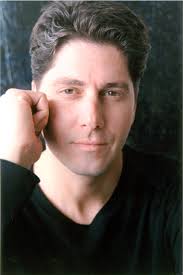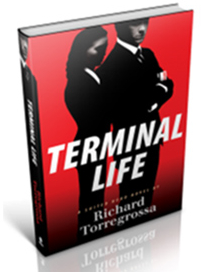An Interview with Richard Torregrossa, Author of Terminal Life: A Suited Hero Novel and Cary Grant: A Celebration of Style
By Bernie Langs
 Several years ago, I was checking the blurbs of recommended articles and reviews indexed by the Arts & Letters Daily web site as I do every day. The site recommended a review of a book about the fashion sense and style of the late, great actor, Cary Grant. Since I admire Grant and his body of work (especially the films done with director Alfred Hitchcock), I clicked and discovered that the book in question was written by a friend I’d worked with at a publishing house. Richard Torregrossa and I became fast friends in the mid-1980s, as we did the dull work of pre-computer copy-editing and marketing, and in his case, copy-writing, editing, and interactions with authors. In addition, we attended book release parties from other publishers where we sipped wine in the evening and hovered in reception room corners while we watched literary types and quietly wise-cracked observations to each other.
Several years ago, I was checking the blurbs of recommended articles and reviews indexed by the Arts & Letters Daily web site as I do every day. The site recommended a review of a book about the fashion sense and style of the late, great actor, Cary Grant. Since I admire Grant and his body of work (especially the films done with director Alfred Hitchcock), I clicked and discovered that the book in question was written by a friend I’d worked with at a publishing house. Richard Torregrossa and I became fast friends in the mid-1980s, as we did the dull work of pre-computer copy-editing and marketing, and in his case, copy-writing, editing, and interactions with authors. In addition, we attended book release parties from other publishers where we sipped wine in the evening and hovered in reception room corners while we watched literary types and quietly wise-cracked observations to each other.
We both lived in Brooklyn and finally Torregrossa, born and bred there, had enough and headed west to seek new opportunities, his fortune, and adventure in California. We contacted each other now and then and I was pleased when he found success utilizing his cartoon drawing skills with several captioned-illustrated books such as Fun Facts about Dogs, The Little Book of Wisdom, Fun Facts about Cats, and the more poetic and meditative The Man Who Couldn’t See Himself.
One phone call we had in the 1990s, was memorable as I listened to a story of how he’d scored a difficult book contract. Torregrossa told me that since he couldn’t afford a literary agent to work the difficult terrain of the competitive publishing business on his behalf, he invented an agent, and sent out inquiries under their name. His fictitious agent made inroads into the business and, one afternoon, Torregrossa received a call from a publisher interested in signing him, but on different terms. Torregrossa said his agent was in the room and advised him to stand his ground. The publisher asked to speak with Torregrossa’s agent. Torregrossa, without hesitation, asked him to hold, took a beat, impersonated his fake agent with an accent and a higher pitch, and worked out the deal.
After I read the online review about Torregrossa’s book, (which includes an introduction written by fashion designer icon, Giorgio Armani), I tracked down his email and we resumed our long-distance friendship. I read many of his erudite and well-written freelance, fashion newspaper columns in major international and U.S. publications and was glad when he became a style consultant with a history of fashion curator at Boston’s Museum of Fine Arts. When Torregrossa delved into fiction with Terminal Life, I read an advance copy. It was just released to excellent reviews. The graphically violent, action novel unfolds at a quick pace, but with twists on the genre. There is a unique hero, Luke Stark, a former Navy SEAL who returns home to learn that his wife was murdered and his son disappeared. And so begins his tale of revenge written through deftly presented prose. The book’s themes examine everything from the value of life to the complications of filial obligations. There’s also a sprinkling of fun and humor. When I finished Terminal Life, I told Torregrossa that the way he artfully managed the book’s deeper ideas was selective and subtle, which packs a more powerful punch and leaves a larger impression.
Torregrossa kindly agreed to be interviewed on the eve of his new book’s release for Natural Selections.
Natural Selections: You’ve written successfully in several genres: non-fiction, fiction, and as a newspaper columnist. Do you find that you use a completely different creative process for each when constructing the work?
Richard Torregrossa: For me the creative process is the same. Whether it’s a novel, a biography, an illustration, or a magazine or newspaper article the challenge is to feel the subject deeply, find a unique angle, and try to say something fresh and interesting using language that resonates. In other words, don’t bore the reader to death.
NS: Your new book, Terminal Life, is action-packed and unfolds almost cinematically. Much of the writing is plot-driven, but at key points, you put in existential, poetic descriptions, and flashes of philosophical thoughts and ideas. Did you place these passages strategically or did they just happen as you were writing?
RT: I wanted the themes to be organic, an integral not a separate part of the novel. For instance, Luke Stark, the protagonist, is a flesh and blood character, but he is also an objective correlative for the most important theme in the novel: Is life worth living? And that is the ultimate existential question.
NS: You’re an expert on the fashion style of Cary Grant. Other movie stars of that era, such as Gary Cooper, also took great care in choosing what they wore, not only in public, but when with friends and family. Do you think there are any high-profile people in entertainment who make that effort on a consistent basis today with such success and elegance—outside of red carpet appearances? The Rolling Stones drummer, Charlie Watts comes to mind.
RT: Interesting you mentioned Charlie Watts because he is a serious sartorialist. I’ve written a lot about G.J. Cleverly, a custom shoemaker in Old Bond Street in London where Charlie has purchased numerous pairs of shoes. They’re beautiful, hand-crafted, like works of art. They cost between $5,000 to $15,000. He’s very friendly with the owner of the company who visited him backstage before a Stones’ concert and Charlie wasn’t wearing Cleverly. The owner was surprised and a little disappointed, so he asked why he was wearing an inferior brand of footwear. Charlie responded, “Because I’m at work, mate.” Charlie cherishes his Cleverlys so much he wouldn’t think of beating them up while working, playing the drums.
 NS: You’ve mentioned to me that some Terminal Life readers were surprised at the level of violence in the book and at the off-handed way you present it. How did you respond to that?
NS: You’ve mentioned to me that some Terminal Life readers were surprised at the level of violence in the book and at the off-handed way you present it. How did you respond to that?
RT: I respond that we live in a violent world and if you don’t realize that then you’re either in denial or existing in some kind of bubble or fantasy. The violence is a reflection of what’s going on in the world; not an exploitation of it. It’s not gratuitous. It’s reality. I was surprised to read that the Dalai Lama and Mahatma Gandhi agree. The Dalai Lama said, “It may surprise you, but I am not strictly opposed to the spectacle of violence and crime. It all depends on what lessons you draw from it.” Mahatma Gandhi said—and this appears on the first page of the novel—“It is better to be violent, if there is violence in our hearts, than to put on the cloak of nonviolence to cover impotence.”
NS: How do you feel about the way that the publishing industry for fiction has changed in the past 30 years or so? In the era of the blockbuster novel, how hard was it to find a publisher for your new book? What advice could you offer first-time novelists trying to break in?
It was very hard. If you compare the rejection letters from agents and editors to the rave reviews it makes you wonder that maybe the inmates are running the asylum. The mainstream publishing industry should not be called an “industry.” It should be called a publishing system, like the education system, a .org, because they are such terrible business and marketing people who really are pathetic when it comes to turning a profit. When I worked at Random House way back in 1983, they were bemoaning the shrinking market for books even back then. What did they do about it? Nothing. They sat behind their desks and whined and complained—and didn’t innovate! But companies like Amazon did and completely stole their lunch by inventing the eBook, the Kindle, etc., and they’re left with the crumbs. Mainstream publishers should’ve done that. And they were very slow to embrace the Internet and they are still befuddled by it and really clueless when it comes to using social media and clever marketing and PR. They are also working off an antiquated model: putting all their eggs in one basket. The resounding failure of Hillary’s Clinton’s new book, Hard Choices, is an excellent example. They paid $14 million for that book (and that doesn’t include all the money they spent on marketing!) and as I write this in its second week of its release, it’s barely sold 85,000 copies […]. How could they be so off the mark? Because they’re lazy. Sign up a celebrity and let the media do the rest. It doesn’t even matter if the book is any good or not. The really tragic implication to my mind is even worse. All that money Simon & Schuster lost? Well, that means less money to buy books by emerging authors, talented authors without name recognition, so they can’t spend the necessary marketing money to promote them and build their audience slowly and efficiently by publishing their books even if they don’t immediately make a ton of money.
NS: You’ve lived in New York City and now reside in California. Does location make a difference in your creative process, either positively or negatively?
RT: Absolutely. I need quiet and solitude and buckets of sunshine to write productively and happily. And a good swim in the afternoon. You just don’t find that in NYC. It’s a city that grinds you down. The infernal subways are an antiquated disgrace. It’s also absurdly expensive, noisy, crowded, filthy, congested, ugly, gloomy, rude, and full of distractions. Where I live now, in San Diego, there’s nothing but blue skies and sunshine and beautiful surroundings—beaches, mountains, rivers, lakes, jacaranda, palm trees, gentle breezes, swimming pools, and people who are generally upbeat and friendly. And they leave me alone. They don’t get in your business. And most of all I can always find tranquility. I’m rarely in a New York state of mind, even though I grew up there.
